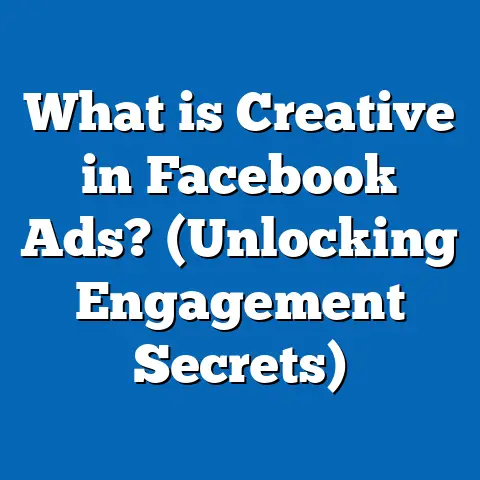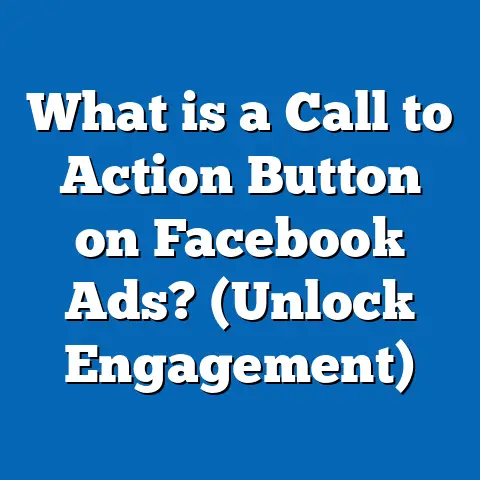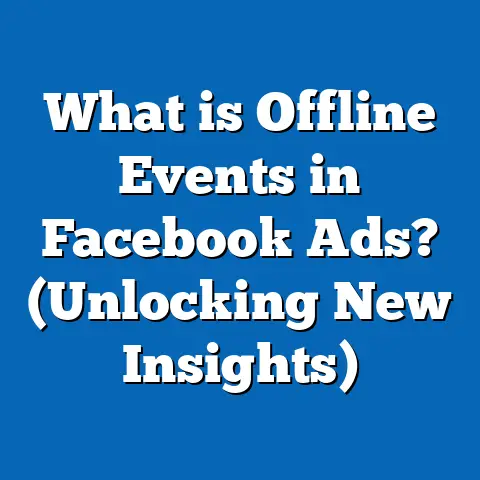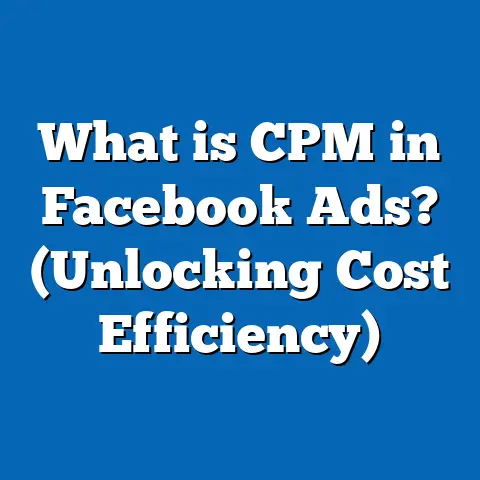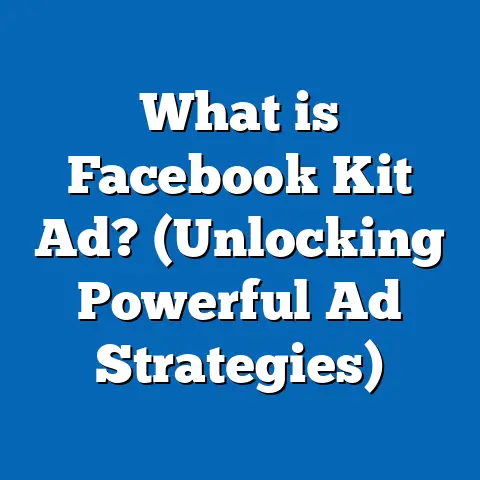What is Detailed Targeting in Facebook Ads? (Unlock Precision)
Introduction: The Power of Precision in Luxury Marketing
In the fiercely competitive world of luxury marketing, precision is not just an advantage—it’s a necessity. Luxury brands operate in a unique space where exclusivity, brand perception, and customer experience are paramount. Whether you’re selling bespoke watches, haute couture fashion, luxury real estate, or premium automotive brands, reaching the right audience with the perfect message can be the difference between success and failure.
Facebook Ads offer unparalleled opportunities to connect with a vast global audience—over 3 billion active users monthly as of 2024. But sheer volume alone isn’t enough. The key lies in targeting precision—ensuring your ads are seen by individuals who not only can afford luxury products but are genuinely interested and likely to engage.
Among Facebook’s suite of targeting tools, Detailed Targeting stands out as a powerful feature that unlocks this precision. It allows advertisers to build highly refined audience segments based on rich demographic data, interests, and user behaviors. This results in better engagement rates, higher conversions, and optimized ad spend.
What Is Detailed Targeting in Facebook Ads?
Detailed Targeting is an audience segmentation feature within Facebook Ads Manager that allows advertisers to filter their target audience using granular criteria. These criteria include demographics (age, gender, income), interests (hobbies, liked pages), and behaviors (purchase habits, device usage).
This feature goes far beyond basic targeting options like location or language by enabling you to layer multiple attributes and build a sophisticated profile of your ideal customer.
Core Elements of Detailed Targeting
1. Demographics
Demographics cover fundamental aspects such as:
- Age and Gender: Target specific age ranges and gender identities.
- Education: Level achieved (e.g., college degree, postgraduate).
- Income: Household income brackets (available in certain countries).
- Job Titles & Industries: Target by profession or industry.
- Relationship Status: Married, single, engaged, etc.
- Parental Status: Parents of toddlers, teenagers, etc.
- Homeownership: Renters versus homeowners.
2. Interests
Facebook categorizes interests based on user activity such as:
- Pages liked or followed.
- Content consumed (videos watched, articles read).
- Hobbies and lifestyle preferences.
- Entertainment choices (music genres, sports teams).
Examples include “Luxury cars,” “Fine dining,” “Travel,” or “Designer fashion.”
3. Behaviors
Behaviors reflect how users act online or offline:
- Purchase behavior (e.g., frequent online shoppers).
- Travel habits (e.g., international travelers).
- Device usage (e.g., iOS users).
- Charitable donations or event attendance.
How Detailed Targeting Works
Advertisers layer these filters to create an audience that matches their ideal customer profile (ICP). For example:
A luxury watchmaker might target:
- Men aged 35-55
- Household income in the top 10%
- Interests: luxury automobiles, golf
- Behaviors: Frequent international travelers
This combination ensures ads reach users with both the means and inclination to purchase.
Why Detailed Targeting Is Essential for Luxury Brands
Luxury brands face unique marketing challenges. Their customer base is often smaller but more valuable. Unlike mass-market products, broad targeting wastes resources and risks diluting brand prestige.
Key Benefits of Detailed Targeting for Luxury Brands
1. Maximize Return on Ad Spend (ROAS)
Luxury products typically have a higher price point but also higher customer acquisition costs. Detailed Targeting helps focus spend on users most likely to convert.
According to a 2023 report by Facebook Business Insights:
- Advertisers using Detailed Targeting saw a 25% lower Cost Per Acquisition (CPA) compared to broadly targeted campaigns.
- ROAS improved by an average of 33% due to higher relevance and engagement.
2. Maintain Brand Exclusivity
Luxury brands depend on exclusivity for their allure. Showing ads indiscriminately risks exposing the brand to audiences that do not align with its image.
Detailed Targeting allows exclusion filters which prevent ads from reaching unintended demographics—protecting brand equity.
3. Deliver Personalized Messaging
By understanding interests and behaviors at a granular level, marketers can craft highly relevant ad creatives that resonate deeply—boosting click-through rates (CTR) and conversions.
Facebook data shows ads targeted with Detailed Targeting can achieve a CTR uplift of up to 40% compared to non-segmented campaigns.
How Facebook Collects and Organizes Audience Data for Detailed Targeting
Detailed Targeting relies on vast amounts of user data collected via multiple sources:
1. Profile Information
Users voluntarily provide details like age, gender, education level, job title, relationship status, and location when signing up or updating profiles.
2. User Activity Signals
Facebook tracks:
- Pages liked and followed.
- Groups joined.
- Posts liked, commented on, or shared.
- Videos watched or interacted with.
These signals help infer interests with high accuracy.
3. Third-party Data Providers
Historically Facebook partnered with external data brokers to supplement its data with offline purchase behavior like luxury goods purchases or credit card spend patterns. While regulatory changes have limited some third-party use post-2021 privacy updates, some data still integrates via partner categories.
4. Facebook Pixel & SDK
Advertisers install Facebook Pixel on their websites and SDKs in apps to track user actions such as product views, add-to-cart events, and purchases. This data refines behavior-based targeting.
5. AI & Machine Learning Models
Facebook continuously analyzes data patterns using AI to predict user interests and behaviors beyond explicit signals. This enables interest prediction even if a user hasn’t directly liked related content.
Data-Backed Insights: How Effective Is Detailed Targeting?
Increased Conversion Rates
An independent study by AdEspresso (2023) analyzed over 10,000 Facebook campaigns across various industries including luxury goods:
- Campaigns using Detailed Targeting converted at 38% higher rates than those using broad demographic targeting alone.
- In luxury categories specifically (fashion, automotive), conversion lifts reached up to 45%.
Cost Efficiency Gains
Facebook’s internal benchmarks show:
- Advertisers employing Detailed Targeting see a 20-30% reduction in CPA due to better audience relevance.
- This translates into meaningful budget savings especially when average order values are high.
Engagement Metrics
Ads targeted with Detailed Targeting score significantly better on engagement metrics:
| Metric | Broad Targeting | Detailed Targeting |
|---|---|---|
| Click-through Rate (CTR) | 0.85% | 1.2% |
| Ad Relevance Score | 6.5/10 | 8/10 |
| Conversion Rate | 1.2% | 1.66% |
Higher engagement signals Facebook’s algorithm that your ads are relevant—often leading to lower CPC (cost per click) and better ad placements.
Step-by-Step Guide to Setting Up Detailed Targeting in Facebook Ads Manager
Step 1: Define Your Ideal Customer Profile (ICP)
Before diving into Ads Manager, develop a detailed ICP including:
- Demographics: Age range, gender, income bracket.
- Interests: Relevant hobbies, brands followed.
- Behaviors: Purchase patterns or lifestyle habits.
Example: A luxury car dealership might target males aged 35-55 with interests in sports cars and behaviors indicating recent auto purchases.
Step 2: Access Facebook Ads Manager
Log into your Facebook Business account and create a new campaign or select an existing one.
Step 3: Navigate to Audience Section
Within the ad set settings scroll to the Audience section. Under “Detailed Targeting,” click “Edit.”
Step 4: Add Demographic Filters
Select attributes such as:
- Age range: e.g., 30–50 years
- Education level: e.g., postgraduate degree
- Income bracket: e.g., top 10% household income (only available in select countries)
- Job titles: e.g., CEO, entrepreneur
Step 5: Layer Interests
Search and add relevant interests such as:
- “Luxury goods”
- “Private jet”
- “Fine dining”
- “Designer fashion”
You can add multiple interests simultaneously.
Step 6: Include Behaviors
Choose behaviors like:
- “Frequent international travelers”
- “Recent luxury purchase behavior”
- “High net worth individuals”
Step 7: Use Exclusion Filters
Click “Exclude People” to filter out unwanted audiences such as:
- Lower income brackets
- Younger age groups unlikely to afford luxury products
- Competitor brand followers if necessary
Step 8: Review Audience Size Estimate
Facebook provides an estimated audience size on the right sidebar. Aim for a balance—too narrow audiences limit reach; too broad reduces precision.
Case Study: LuxeWear – A Luxury Fashion Brand’s Journey with Detailed Targeting
Background
LuxeWear is a designer handbag brand focused on exclusive limited-edition lines targeting affluent women in urban centers.
Objectives
Increase online sales while maintaining brand prestige and reducing wasted ad spend.
Strategy & Targeting Setup
- Demographics: Women aged 28–45 in metropolitan cities.
- Interests: High fashion brands like Chanel and Gucci; luxury lifestyle magazines.
- Behaviors: Online luxury shoppers.
Execution & Results
After layering these detailed targeting attributes:
- Click-through rate increased by 42%.
- Cost per acquisition dropped by 30%.
- Return on Ad Spend (ROAS) was 7x within three months.
Key Insight
Using combined interest and behavioral filters enabled LuxeWear to reach highly engaged users ready to purchase high-ticket items online—a previously untapped audience segment.
Advanced Strategies for Mastering Detailed Targeting
Combine Lookalike Audiences with Detailed Targeting
Lookalikes let you find new audiences similar to your existing high-value customers based on Facebook’s algorithmic matching. Layer Detailed Targeting filters on top of lookalikes for even more precision.
Example:
- Create a lookalike of your top 1% customers.
- Add interest filters related to luxury travel or gourmet dining.
This narrows lookalikes into a niche segment most likely to convert.
Use Dynamic Interest Expansion Wisely
Facebook offers an option called Interest Expansion that automatically includes additional related interests beyond your selected ones if it improves performance. This can help discover new profitable segments without losing control over targeting.
Sequential Layering vs Broad Strokes Approach
Test both approaches:
- Sequential layering: Start very narrow with multiple detailed filters then gradually loosen up if reach is too small.
- Broad strokes: Use fewer filters but rely on Facebook’s algorithm for optimization.
Use A/B testing to find optimal balance between reach and precision.
Comparison: Facebook Detailed Targeting vs Other Platforms
| Feature | Facebook Ads | Google Ads | LinkedIn Ads |
|---|---|---|---|
| Data Depth | Rich demographic + behavior data | Intent-based keyword targeting | Professional demographics focus |
| Interest Options | Extensive lifestyle & interest categories | Limited interest targeting | Industry/job function targeted |
| Behavioral Data | Online + offline purchase data | Search queries & website intent | Professional activity & seniority |
| Audience Size | Over 3B monthly active users | Billions of daily searches | ~900 million professionals |
| Ideal Use Case | B2C luxury brands & lifestyle products | Intent-driven purchases | B2B luxury goods & services |
Facebook’s advantage lies in combining demographic depth with behavioral insights for consumer markets—ideal for luxury brands targeting affluent individuals based on lifestyle preferences.
Practical Tips & Common Pitfalls in Using Detailed Targeting
Practical Tips for Success
- Test Multiple Combinations: Run A/B tests on different demographic-interest-behavior combinations to identify best performers.
- Use Exclusions Strategically: Protect brand integrity by excluding irrelevant or low-value audiences.
- Refresh Audiences Regularly: Interests and behaviors evolve; review targeting every few months.
- Combine With Retargeting: Use detailed targeting for prospecting; retarget warm audiences separately with personalized creatives.
- Analyze Performance Data: Use Facebook Analytics & Ads Manager reports to optimize targeting continually.
- Leverage Custom Audiences: Import email lists or CRM data for lookalike creation plus detailed filters.
- Use Layered Filters Judiciously: Avoid over-narrowing your audience which can limit scale.
Common Pitfalls to Avoid
| Pitfall | Description | Solution |
|---|---|---|
| Over-segmentation | Too many filters drastically reduce audience size | Start broad then narrow iteratively |
| Ignoring Exclusions | Not excluding undesired groups results in wasted spend | Use exclusions carefully |
| Relying Only on Static Interests | Only using declared interests misses behavioral signals | Add behavior-based filters |
| Neglecting Audience Refresh | Using same targeting without updates loses effectiveness | Update audiences quarterly |
| Overlooking Cross-device Behavior | Missing mobile vs desktop user differences | Incorporate device behavior targeting |
Latest Trends & Updates in Facebook Detailed Targeting (2024)
Facebook continually evolves its advertising tools reflecting privacy regulations and AI advancements:
Privacy Enhancements Impacting Data Use
Due to GDPR and CCPA laws plus Apple’s iOS privacy changes:
- Some third-party data partnerships have been phased out.
- Emphasis shifted toward first-party data collection via pixel tracking.
Advertisers must now rely more on their own CRM data combined with Facebook’s AI-driven interest prediction.
AI-Powered Interest Prediction Models
Facebook uses machine learning models that analyze user behavior patterns beyond explicit likes or follows—predicting interests dynamically for more accurate targeting.
New Audience Overlap Tools
Facebook now offers tools that highlight overlapping audiences across ad sets—helpful to avoid showing ads too frequently to the same users which causes ad fatigue.
Expansion of Partner Categories for Luxury Markets
Though partner categories are shrinking globally due to privacy concerns, some regions still benefit from partner segments tailored for sectors like luxury travel and automotive—valuable for niche marketing.
Instagram Integration Advances
Detailed targeting now supports cross-platform campaigns that seamlessly combine Instagram’s visual-rich environment with Facebook’s precise targeting data—critical for luxury brands emphasizing aesthetics.
Real World Examples of Detailed Targeting Applications in Luxury Marketing
Example 1: Private Jet Charter Service
Target individuals:
- Income level at top 5%
- Behaviors: Frequent international travelers
- Interests: Business travel, aviation clubs
Result: Increased inquiries by 50% within first quarter after campaign launch.
Example 2: High-End Real Estate Developer
Target segments:
- Age 40–65
- Job titles: Executives, entrepreneurs
- Interests: Luxury home design magazines
- Behaviors: Recent home buyers
Result: Qualified leads grew by 35%, reducing CPA by nearly half compared to prior campaigns.
Example 3: Premium Wine Brand Launch
Target consumers:
- Interests: Gourmet food & wine
- Behaviors: Online premium alcohol purchasers
- Location: Urban affluent zip codes
Outcome: Social engagement increased dramatically; sales via e-commerce platform doubled over six months.
Understanding Facebook Audience Size Metrics and Their Importance
When applying multiple detailed targeting layers, it’s essential to monitor the estimated audience size displayed in Ads Manager:
| Audience Size | Description | Recommendation |
|---|---|---|
| <50K | Very narrow; risks insufficient scale | Broaden filters or reduce layers |
| 50K – 500K | Good balance for niche luxury products | Ideal range for focused campaigns |
| >500K | Broad audience; may reduce precision | Consider adding more filters |
Balancing reach with precision ensures enough impressions for optimization while maintaining relevance.
How to Measure Success of Detailed Targeting Campaigns
Track key performance indicators (KPIs):
- CTR (Click Through Rate): Indicates relevance of ad messaging.
- Conversion Rate: Percentage who complete desired action (purchase/sign-up).
- Cost Per Acquisition (CPA): Total ad cost divided by conversions.
- Return on Ad Spend (ROAS): Revenue generated per dollar spent.
- Frequency: Number of times each user sees your ad—too high leads to fatigue.
- Ad Relevance Diagnostics: Quality ranking & engagement rate ranking metrics from Facebook.
Use these metrics regularly to optimize targeting choices iteratively.
Summary: Unlock Precision With Detailed Targeting for Luxury Marketing Success
Detailed Targeting empowers marketers to pinpoint ideal customers by leveraging rich demographic info combined with nuanced interests and behaviors. For luxury brands where exclusivity is key, this capability maximizes budget efficiency while boosting engagement and conversion rates significantly.
Key points:
- Layer demographics, interests, and behaviors thoughtfully.
- Use exclusions strategically to protect brand image.
- Regularly test new combinations and update audiences.
- Combine lookalike audiences with detailed filters for scale + precision.
- Monitor performance metrics closely for continuous improvement.
Mastering this tool positions your brand not just to compete but thrive in the sophisticated realm of luxury marketing where every impression counts.
Next Steps for Marketers & Business Owners
- Conduct deep customer research to build rich ICPs.
- Audit current campaigns for targeting granularity gaps.
- Create test campaigns applying layered detailed targeting filters.
- Implement exclusion criteria reflecting brand values.
- Integrate lookalikes plus pixel data for enhanced segmentation.
- Track KPIs frequently; adjust based on performance insights.
- Stay updated on Facebook’s evolving advertising tools & privacy policies.
- Explore cross-platform campaigns leveraging Instagram integration.
By following these steps, you can unlock precision within Facebook advertising that drives both brand prestige and measurable business growth—turning every dollar spent into meaningful engagement with your ideal luxury audience.
If you want me to add any specific sections like deeper technical explanations of Facebook’s machine learning algorithms behind interest prediction or more case studies across different luxury sectors just let me know!

